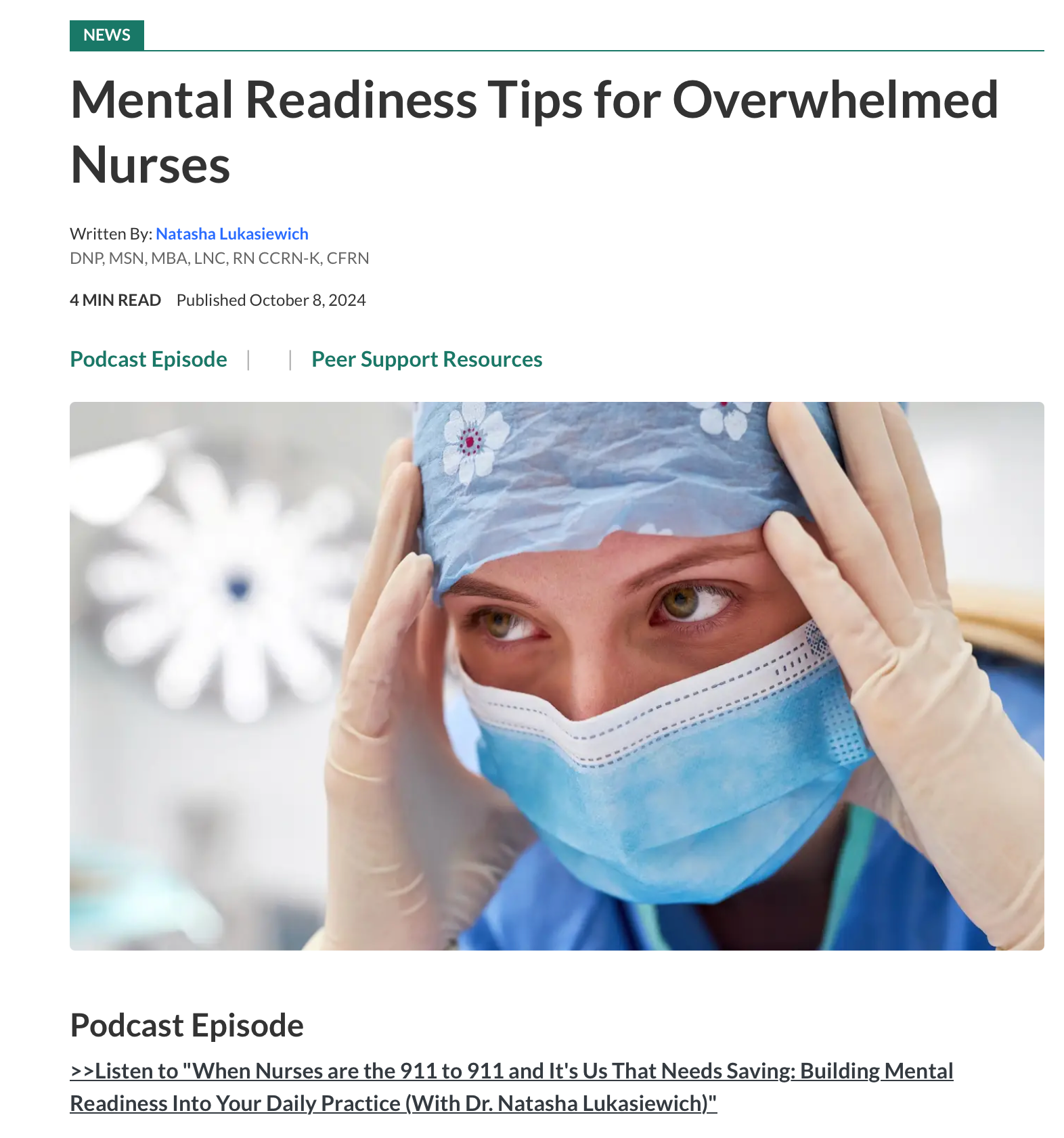Nurse Converse Season 2 Podcast
Nurse Converse Podcast Season 2
Podcast Episode

https://nurse.org/news/mental-readiness-for-nurses/
Click above to listen and read this guest Podcast episode with Nurse.org
In the very challenging world of nursing and the healthcare realm, where healthcare professionals are often the first and last responders to patients and the 911 system. It's imperative to address an often-overlooked aspect of healthcare: the mental readiness of those who are the backbone and heartbeats of healthcare.
So why is it, metaphorically speaking, that some individuals leap into the raging rivers without rescue equipment, and we do not have the mental health resources to scoop them up downriver? And what happens when those who are supposed to be the safety net find themselves with no safety net at all? It is time that we start going upriver and figure out why people are jumping in before it’s too late. This is where proactive mental readiness tools can assist.
In the recent Nurse Converse Season 2 podcast, I shared my personal journey navigating the traumas of nursing and healthcare. While my personal and professional experiences are not unique, they underscore a significant issue: the need for robust mental health support within our profession, and the sad reality is that we are not there yet. We can and must do better. Building peer support and dismantling the stigma around seeking help are vital steps toward ensuring that no one is left behind. Organizations must choose to invest in the mental readiness culture, or it will be too late, and those who leave may never come back. No human should feel like they are drowning, especially in their work environment, and most of all should not be jumping in the raging rivers without proper rescue gear.
Peer Support Resources
Here are some resources and tools I speak of in the podcast to help establish and promote building strong Peer Support Teams and enhance your mental readiness resilience:
- Peer Support Teams: Building an effective Peer Support Program can provide crucial emotional support and resilience. For practical steps to set up a Peer Support Program in your organization, visit NVPSN’s resources. These resources offer a foundational guide to getting your peer support program off the ground and access to mentor support.
- PROQOL Health Tool: The Professional Quality of Life (PROQOL) Health tool is measure for assessing various aspects of professional life including Burnout, Compassion Fatigue, Compassion Satisfaction, Moral Distress, Perceived Support, and Secondary Traumatic Stress. Take your personal assessment and access helpful manual resources here: PROQOL Health. Whether these terms resonate with you or not, exploring this tool can offer insights into your own professional well-being within the last 30 days. You can also share it with your team members and help build a psychologically safe culture. The screenshot below shares a synopsis of some of the concepts covered.
3. Emotional Self-Awareness/Insight: Understanding your emotional state is key to maintaining mental readiness. We are never really taught how to identify and process our big emotions. Consider taking a moment each day, before, during, and after your shift to assess your emotional "color state" as a simple way to gauge your mental health and well-being. This practice can help you become more self-aware and proactive in managing your emotions. It’s like triaging your feelings like you would if someone was coming into the emergency department and triaging them with chest pain, shortness of breath or stroke-like symptoms. This tool gives our mind a way to be validated to be a ‘regular organ’, just like our heart, lungs, and muscles. In 2019, I wrote an article for the International Public Safety Association (IPSA) discussing the Emotional Mental Readiness Tool. Explore this article to gain further insights: IPSA Blog.
- End-of-Shift Checklist: Rather than another clinical checklist, try incorporating a reflective end-of-shift routine. This approach helps you process your work experiences, reset, and prepare for the journey home. Training your brain to adopt an infinite mindset vs finite mindset (thank you Simon Sinek), you can enhance your resilience and enable you to navigate and process the challenges you face with in your shift. Feel free to utilize this infographic below.
In closing, I invite you to review my work via my DNP manuscript from 2019, which focuses on promoting staff resilience through distress defusing via Code Lavender. My performance improvement project took place in a very busy level 2 trauma ICU. For an in-depth look, access the full manuscript here: DNP Manuscript. An abbreviated version of my DNP abstract is available here: DNP Abstract.
I hope these resources and insights support and enhance both your personal and professional practices. Let’s continue to connect and support each other on this journey. Feel free to reach out to me on LinkedIn: Natasha Lukasiewich. I am always inspired by my connections and hope I can inspire come in return.
As we wrap up, remember your “UBUNTU” (Humanity in Others)—check in with your colleagues and take care of yourselves. I’ll close this article with some of the amazing nursing adventure photos from my career. Keep raising the bar and supporting one another in this noble profession! Remember, it's okay to not be ok, just make sure you have your peer to help you navigate those big emotions.
a b c d e f g h i j k l m n o - Do not remove from template!!! it is important to support different fonts

1-805-996-0174